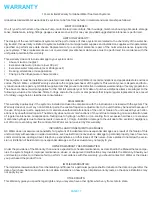
Taking Measurements
1. Remove the cap. (Do not use the cap for testing.)
2. Click the POWER button. The reading will always be zero in the air.
3. Make sure the TDS meter is set to test a 0.7 factor (442). It should say 0.7 in the top right of the screen. If not switch
the modes by following the directions in “Switching Modes”.
4. Dip the meter’s sensor into the water, liquid or solution to be tested.
5. Lightly swirl the meter to ensure the removal of air bubbles or electric charges.
6. The meter will display a reading instantly. Keep the meter in the water until the reading stabilizes (up to 5 seconds,
depending on the situation).
7. To view the reading out of the liquid, click the HOLD button. This will freeze the reading on the screen. Clicking HOLD
again will release it.
8.
Click the POWER button to turn the meter off.
9.
Shake any excess water off the meter and rinse with low TDS water (such as distilled, RO or DI), or use compressed
air to clean it. Put the cap back on.
Switching Modes
1. With the meter on, press and hold the MODE button.
2. The scales will cycle through on the display screen.
3. Release the MODE button when the desired scale is shown.
Temperature And Switching Temperature Modes
1. The temperature reading is always displayed on the LCD panel (except in calibration mode), and is shown simultane-
ously with EC/TDS readings.
2. The default mode for temperature is Celsius. To change the temp mode, quickly click the TEMP/CAL button to switch
from Celsius to Fahrenheit or vice-versa.
Care & Maintenance
1.
If using the COM-80 for nutrients or high TDS solutions. ALWAYS RINSE THE SENSOR AFTER EACH USE. Rinse in
distilled or RO water, but tap water can also be used. Improper care will negatively affect readings and void the war
-
ranty.
2.
Your meter has been factory calibrated, which is sufficient for most applications. The COM-80 will retain its calibration
for a long period of time, but recalibration may be necessary based on frequency of use, care and application of use.
3. Ideally, store the sensor dry (it should never be stored in water or a solution).
Changing the Batteries
1.
When the meter displays a flashing battery symbol, your batteries are getting weak and should be replaced soon. To
change the batteries:
2. Pull out the blue battery compartment using your thumb nail.
3. Remove the three batteries.
4.
Insert new batteries in the direction as depicted inside the compartment. The flat side of the battery is the po)
side. The meter uses LR44 batteries.
5. Close the battery compartment. Make sure it is tightly closed.
Calibration
Calibrating a scientific instrument is similar to tuning a musical instrument. Your COM-80 has been factory calibrated to
1413 µS (700 ppm), which is suitable for most applications, and is ready for immediate use. The meter will retain its cali-
bration for many years, depending upon care, frequency of use and application of use. If you need to recalibrate:
1.
Obtain a certified EC/TDS calibration solution. Always calibrate close to the level you will be testing (or in the middle
of a range) .
2. Turn the meter on and insert into the solution. (Make sure the meter’s mode matches the composition of the solution).
If your meter shows the correct reading, stop here. If not, press and hold the CAL button for 5 seconds. The display
will flash and the temperature reading will change to a flashing ‘CAL’ image.
3. Adjust the reading to match the solution value with the UP or DOWN buttons (indicated by the arrows). When the
number matches the solution, click ENTER.
4.
‘CAL’ will flash briefly, indicating progress. Allow a few seconds, do not press any buttons, and if possible, do not move
the meter.
5.
When the meter is calibrated, ‘End’ will flash and the measurement will reappear.
6.
Temperature Calibration
If you need to calibrate the COM-80’s thermometer, only calibrate it in the air to a different, correct thermometer.
1.
With the meter on and in the fill:, press and hold the POWER and TEMP buttons at the same time for 5 seconds.
2.
‘CAL’ and the temperature will flash on the screen.
3. Using the UP or DOWN buttons (arrows), adjust to the correct temperature.
4.
Once you have corrected the temperature, click ENTER. ‘C -- CA -- CAL’ will flash on the screen and then ‘End’ will
briefly appear. The thermometer is now calibrated.
HAND HELD TDS METER
PAGE 11



































